The ability to change the brightness of the lighting and create different lighting scenarios is becoming a necessity for a modern home, like connecting to the mains or the Internet. Therefore, luminous flux regulators or dimmers for LEDs are recommended to be installed with each update of the wiring in the apartment.
Dimmer functions
The dimmer with functional key illumination is not only convenient, but looks stylish in the interior
The functionality of dimmers depends on the complexity of the device. The simplest ones that you can do with your own hands are used only for stepwise or smooth changes in the intensity of the lamp glow. More modern models equipped with microcontrollers can perform other tasks:
- Fine tuning lighting. The dimmer helps to adjust the comfortable brightness of lighting fixtures depending on the intensity of natural light throughout the day, the orientation of the room to the cardinal points, the design of the window opening, the habits and preferences of the owners. This is much more convenient than choosing lamps of the required power for each group of luminaires.
- Automatic shutdown at the specified time. This feature saves the owner the hassle of checking every room before going to bed/going out and helps reduce electricity bills.
- Save money on lamps. Working in a reduced brightness mode, LED lamps and incandescent lamps are able to perform their functions 3-5 times longer than planned.
- Simulation of the presence of the owners. The device turns on and off, and also changes the brightness of the lamps connected to it, imitating the actions of people living in the house. The program is designed specifically for those who regularly leave their homes and are afraid of burglars.
- Remote control of light: via remote control, voice commands, application on a smartphone. This is convenient not only in large rooms, but also in bedrooms, when you don’t want to get out of bed in the evening.
Dimmers can be installed both for a single lamp / chandelier, and for a group of luminaires. More often, a separate dimmer is provided for each group of lighting devices of each functional area.
In addition to living rooms, concert venues, theater halls, circus arenas and other premises where smooth lighting control is necessary for a visual effect are supplied with devices of this type.
How does a LED dimmer work?
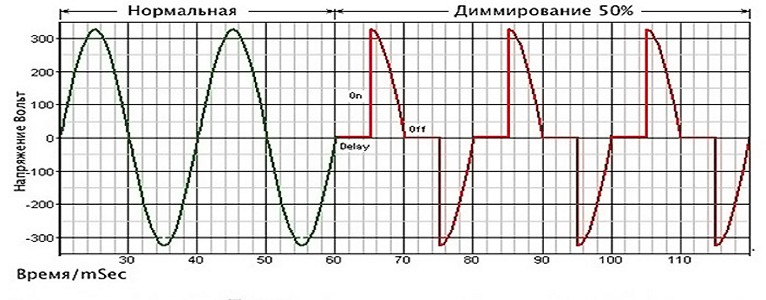 Schematic showing how a dimmer converts a normal AC curve
Schematic showing how a dimmer converts a normal AC curve
The principle of operation of the device is based on changing the voltage in such a way as to cut off the leading (“adjustment on the leading edge”) or trailing (“adjustment on the trailing edge”) edge of the AC sinusoid (“phase cutoff principle”). Thus, when dimmed to 50%, the lamp uses only half of the possible power.
Leading edge dimming is used with 230V low voltage, fluorescent and LED lamps complete with electromagnetic type transformers. Trailing edge dimming is used for the same lamps in tandem with electronic transformers.
The task is performed using a rheostat or a complex of electronic elements. Rheostatic type dimmers are characterized by low efficiency (coefficient of performance) and do not reduce energy consumption when lighting decreases, therefore they are gradually becoming obsolete. Electronic dimmers work by using a bi-directional thyristor and a PWM (pulse width modulation) system that delays the load activation signal. When operating at full power, there is no delay, at 10% luminosity it is 9 milliseconds. Thus, the dimmed lamp is constantly switched off and on with a slight delay.
For normal operation, the device is equipped with protection against overheating and short circuit.
The dimmer is able to prevent damage to the lamp during regular voltage drops.
Compare the advantages and disadvantages
 Details about the pros and cons of devices
Details about the pros and cons of devices
| pros | Minuses |
| Allows you to reduce the energy consumption of the room. | They are expensive, especially programmable models with touch and remote control. |
| Extend the life of the lamps by reducing the intensity of operation, as well as a smooth start when turned on. | They lead to malfunctions and destruction of lamps if the devices are not selected correctly. |
| Protect the premises from the intrusion of strangers. | Budget devices generate electromagnetic interference that degrades the operation of radio equipment. |
| They provide a decorative effect and eye-pleasing illumination in any room. | Not suitable for use with fluorescent/energy-saving/halogen lamps, as the latter are equipped with a compensation system for a stable glow. |
| They make the lighting design of the room more interesting and variable. | If the load on the dimer has become less than the minimum allowable (for example, an incandescent lamp has been replaced with an LED one), the device will quickly deteriorate without the possibility of replacement under warranty. |
If you decide to use a dimmer in your home or office, try not to save on appliances and use the advice of a sales assistant to choose the best dimmers and lamps for each other. Then you are guaranteed to avoid the appearance of unpleasant effects.
Varieties and characteristics of dimmers for LED lamps
When buying a dimmer, keep in mind that the devices for incandescent lamps, energy-saving lamps and LEDs differ from each other. Therefore, you need to take either a specialized device, or select LED lamps marked "DIMMABLE" / a circular icon for a standard one.
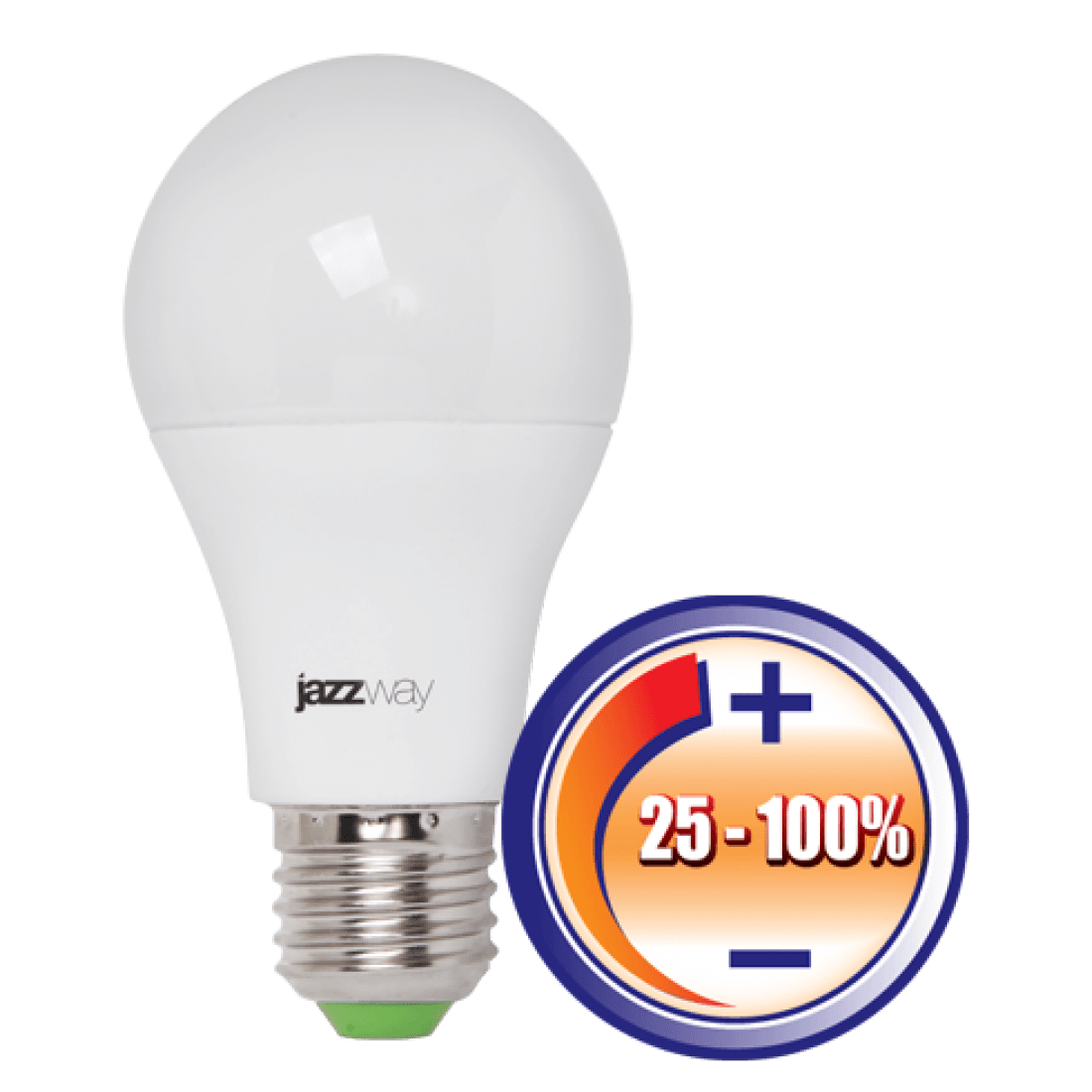 Such an icon on the box means that the LED lamp will work with a universal dimmer. Minimum luminosity level may vary or may not be specified
Such an icon on the box means that the LED lamp will work with a universal dimmer. Minimum luminosity level may vary or may not be specified
Demonstration of work with different types of lamps
Classification of regulators
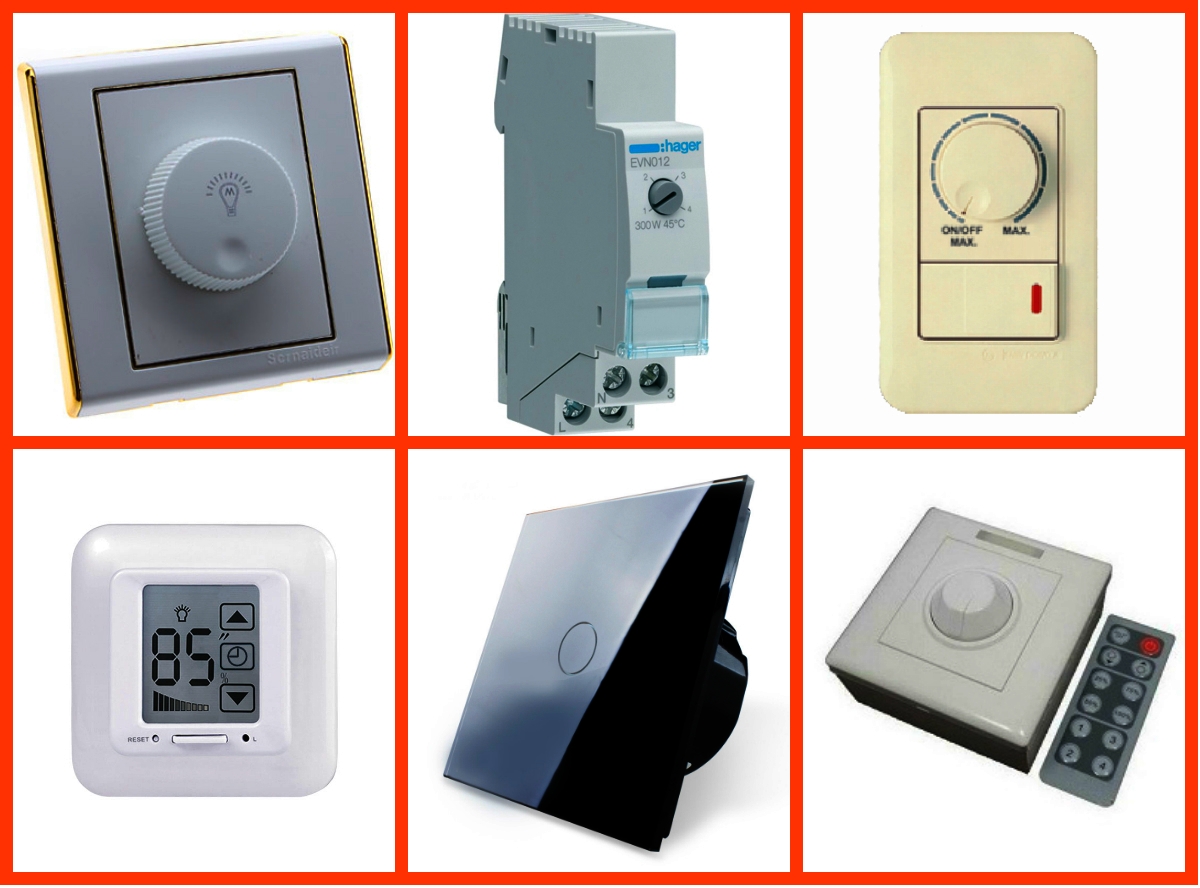 Dimmers with different control principles
Dimmers with different control principles
Depending on the principle of controlling devices, dimmers for LED lamps are:
- Turn-and-push. The most common type of dimers, such devices are easy to operate, have a low price and a simple design. The control is intuitive: the brightness is changed by turning the knob, turning on / off is done by pressing. Users appreciate the ability to turn the light on and off without changing the selected brightness setting.
- Keyboards. The devices resemble ordinary switches, which allows you to choose the most suitable design for dimmers, switches and sockets. The desired degree of brightness is set with the +/- key, switching on and off - with the I / O button (or with a key without an inscription).
- Touch. The devices are controlled by a tactile sensitive screen, which can display auxiliary information. Dimmers of this type are distinguished by their actual, sometimes even futuristic design, which is why they are often installed in modern interiors.
- Remote. Such devices are not installed in the user's direct access zone, they are mounted near the lamp or in the electrical panel of the apartment. The control takes place using the remote control or from any gadget via WiFi (you will need to download and install the appropriate application).
Choosing the right type of dimmers depends on your convenience, the design of the room, and the budget allocated to the fixtures.
![]() Types and schemes for connecting dimmers
Types and schemes for connecting dimmers
Devices are also classified according to the method of installation:
- Modular are designed for installation in a switchboard on a DIN rail (next to circuit breakers). Such devices can be mounted or replaced at any time, you only need to provide a separate wire for it during repairs.
- Wall-mounted are installed in the same way as sockets and switches directly in the room where the luminous flux will be regulated. Installation is carried out at the end of the repair simultaneously with the specified devices. It is very difficult to add such a dimmer after repair, as wall chasing and destruction of the finish will be required.
- Remote ones look like miniature (2-3 cm long) blocks with three control sensors. Since they are able to be controlled remotely, they are installed under a suspended/stretch ceiling next to a chandelier or inside a lighting fixture. Dimmers of this type can be mounted simultaneously with the luminaire (the walls do not need to be chiseled, so no repairs are required).
If you are planning to equip a smart home system, modular models will suit you; planning repairs without a smart home - prefer wall-mounted ones; if the repair has already been made, only remote ones can be installed without risk for finishing.
Popular dimmer manufacturers
 Marking of dimmers manufactured by Legrand
Marking of dimmers manufactured by Legrand
- Legrand (Legrand). The French company offers products of European quality, certified according to GOST. Advantages of Legrand dimmers: ease of installation, reliable operation, attractive design (colors: ivory, white, aluminum). The manufacturer offers models of rotary, push-button and touch types.
 Marking of dimmers manufactured by Schneider Electric
Marking of dimmers manufactured by Schneider Electric
- Schneider Electric (Schneider Electric). The German manufacturer is known for the quality and high reliability of its dimmers. Several series of devices with different designs and seven color variations have been developed. The devices are equipped with mounting tabs and guides that facilitate the installation procedure.
 Marking of dimmers manufactured by Makel
Marking of dimmers manufactured by Makel
- Makel (Makel). The Turkish brand has a more loyal pricing policy than European manufacturers. Masters recommend using devices of this brand in low-load areas, where they demonstrate sufficient reliability.
Each manufacturer attaches to their dimmers information about their compatibility with various types of lighting devices. It is usually provided by brand representatives or consultants at the point of sale.
How to choose a device
When choosing a dimmer, the following parameters must be taken into account:
- Planned load (total power of connected lamps). The documentation for the dimmer indicates the load power of the device, it should be one third more than the sum of the powers of the luminaires it controls. It is no longer worth making a power reserve, as this will lead to damage to the dimmer.
- Mains voltage. LED lamps are designed for 220V or 12V circuits (work through a transformer). Dimmers for them are produced differently, so make sure that the box is labeled 220V.
- Light fixture compatibility. The instructions for the device should say that it works with LED lamps (not diodes or tapes), and not with incandescent lamps.
The choice of a dimmer by type of installation and brand is written above. For maximum compatibility of devices, we recommend buying a set of dimmers and lamps at the same time and checking their collaboration in the store.
DIY connection
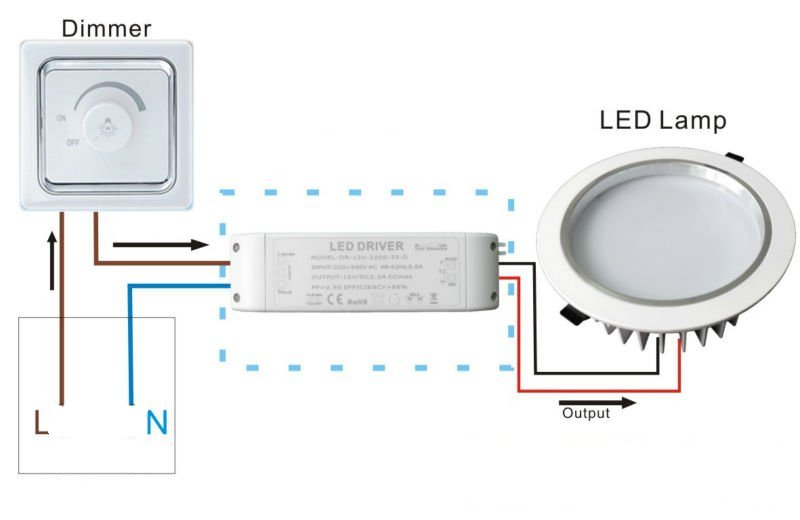 Demonstration of the correct connection of wires
Demonstration of the correct connection of wires
Installing a dimmer is not difficult for an ordinary electrician and even a person who is only slightly familiar with such work. To connect a remote dimmer, it is enough to connect the wires by connecting one side to the wiring, and the opposite side to the lamp (so that the “phase” and “zero” are not mixed up, all wires are marked). Modular, as already mentioned, are mounted on a DIN rail in the electrical panel. It is better to entrust this work to a professional so as not to accidentally disrupt the work of neighboring elements.
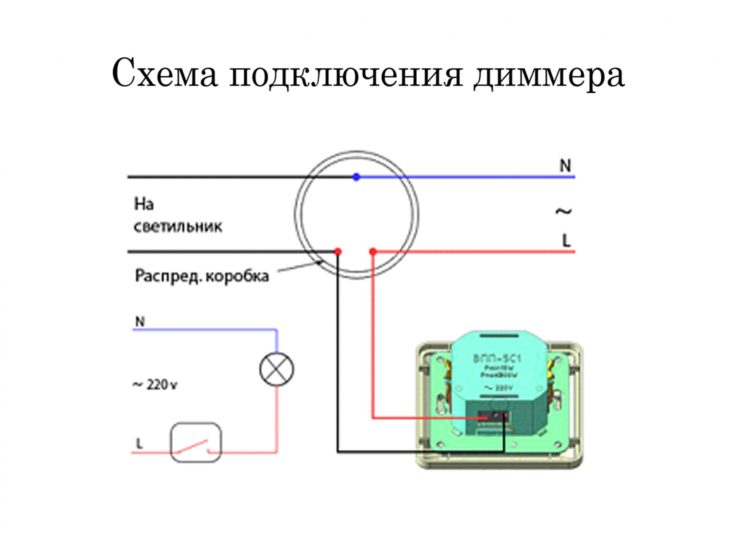 Pay attention to the location of the contacts for connecting wires
Pay attention to the location of the contacts for connecting wires
The installation procedure for the wall regulator is the same as for a conventional socket. Let's describe in more detail the rules of work and safety requirements:
- determine the phase wire with an indicator screwdriver;
- turn off the power supply to the room / apartment (depending on the capabilities of the shield);
- connect the phase conductor and the dimmer wire with the “L” marker, and connect the neutral conductor to the wire marked “N”. This can be done by twisting (provides a large conductor contact area) or by special clips (more convenient and faster, especially for beginners).



